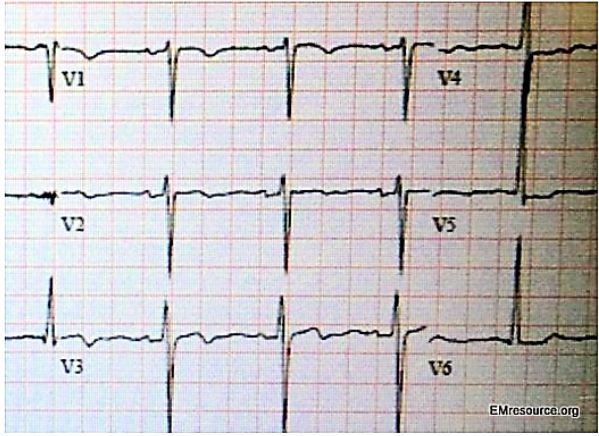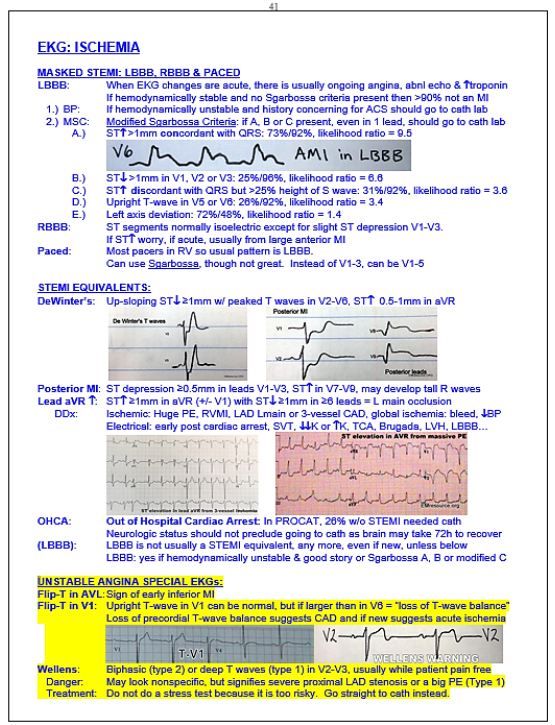ECG Challenge: Severe Episodic Chest Pain in a 31-year-old Woman
The chest pain is non-pleuritic, non-exertional, and is worse when the patient is supine. What is your read of the ECG?
Figure 1. (Please click to enlarge)

Figure 2. Page shot (please click to enlarge)

A 31-year-old woman presents to the emergency department (ED) for one week of episodic, non-pleuritic, non-exertional chest pain. She states she has between 5 to 10 episodes per day, each lasting about 2 to 3 minutes. The pain is severe and radiates to her back, arms, and jaw and seems to occur more frequently when she is lying down. Her regular doctor started her on an antacid 2 days ago but she has noticed no improvement. If anything, she states, the episodes are lasting longer today, especially the most recent one, which lasted approximately 20 minutes. Her own medical history is noncontributory but there is a family history of coronary disease, though no early coronary disease. She does not smoke tobacco and denies illicit drug use.
Examination: Vital signs are normal, including bilateral BP. Head and neck exam is also normal. Lungs are clear and heart sounds are regular with no appreciable murmur. There is no edema and peripheral pulses are intact.
Initial impression: Esophageal spasm
Initial testing: Chest x-ray is normal; ECG tracing is shown at right (please click on image to enlarge).
Questions:1. How do you interpret the ECG findings?
2. What should you do next?
Please click “next” below for answers and discussion.
Answers:
1. How do you interpret the ECG findings? The ECG tracing shows some subtle ST depression in the far lateral leads (V4-V6) as well as a subtle Wellens type 2 pattern in V3 (biphasic T waves).
2. What should you do next? Order cardiac enzyme testing and admit patient.
Discussion
Acute coronary syndrome (ACS) is very rare in premenopausal women, and so therefore is more likely to be missed when it does occur. It is critical to be aware of the limitations of the physical examination and testing in the ED to rule out ACS, especially when episodes of chest discomfort last less than 30 minutes, because the troponin level may never elevate. Fortunately in this case the ECG remained abnormal during the pain-free period.
The ECG tracing obtained in the ED presents multiple abnormal findings as mentioned above. There are two types of Wellens pattern: Type 1, with T-wave inversion in the precordial leads and Type 2, with biphasic anterior T-waves. Type 2 is more likely to be dismissed as non-specific, but should raise concern for severe coronary stenosis. (see highlighted part of page shot for more info).
It is also important to understand the limitations of troponin measurements. It takes approximately 12 to 24 hours for troponin levels to peak after an ischemic event and the enzyme may not be released in short episodes (lasting less than 10 to 30 minutes). Thus, the troponin measure may be a false negative in early ACS or when episodes are short. In this case the initial troponin was normal, as was a repeat troponin at 2 hours, but it did eventually rise.
Case Conclusion
A coronary CT scan showed 50% to 70% stenosis in the mid-left anterior descending artery. The patient then called family members and found out that there actually was a history of premature coronary artery disease. Coronary catheterization was done and based on flow and anatomy the decision was made not to stent. The patient continued to have chest pain, however, and the troponin level eventually rose to 0.42 µg/L with dynamic ECG changes so she had a second catheterization and a stent was placed at that time.